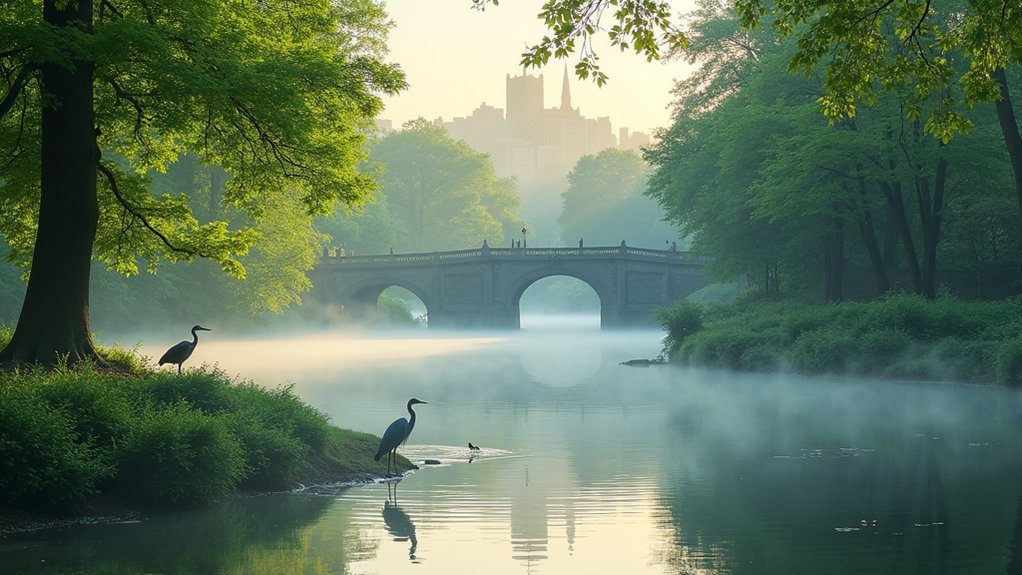Urban bird photography doesn’t require travel to remote wilderness. You’ll find surprising biodiversity in hidden greenways, overlooked waterfront corridors, abandoned industrial parks, rooftop gardens, and urban stream buffers. These secret spots offer opportunities to capture diverse species from warblers to raptors in unique urban contexts. Morning visits to stream edges or elevated garden sanctuaries can yield dramatic shots with perfect light. Discover these five unexpected locations and transform your city bird portfolio.
Hidden Greenways: Secret Pathways for Urban Avian Photography

Sanctuaries within concrete jungles, urban greenways offer photographers a golden opportunity to capture avian life without leaving city limits.
These interconnected pathways serve as essential habitats where birds find food and build nests, making them premier urban wildlife hotspots.
You’ll discover hidden trails linking parks and natural areas throughout the city, leading to less-disturbed environments where unique species thrive.
Many of these birding destinations strategically align with major flyways, allowing you to photograph migratory birds during peak seasons.
The diverse ecosystems—from wetlands to woodlands—attract varied bird species year-round.
Take advantage of observation platforms and benches positioned along these greenways, providing perfect vantage points to capture stunning images of birds in their natural settings.
Overlooked Waterfront Corridors That Connect City Bird Habitats
Urban waterfront corridors form essential yet underappreciated networks for bird species, creating linear ecosystems that photographers often miss while focusing on more obvious locations.
You’ll find these waterfront pathways connect critical habitats while offering unique photography perspectives.
- East End Lagoon in Galveston provides year-round birding opportunities against scenic city backdrops.
- Baytown Nature Center features over 300 bird species along its extensive waterfront habitats.
- Cattail Marsh in Beaumont spans 900 acres with excellent vantage points for capturing shorebirds.
- Surfside Bird and Butterfly Nature Trail includes a two-mile walk perfect for photographing diverse species.
These corridors don’t just connect habitats—they offer you distinctive photography angles where urban elements meet natural environments.
When you’re planning your next birding excursion, don’t overlook these waterfront gems that deliver both biodiversity and compelling compositions.
Abandoned Industrial Parks: Unexpected Havens for Bird Diversity

While photographers often flock to established nature preserves, abandoned industrial parks have quietly transformed into unexpected havens for bird diversity.
These forgotten spaces offer a unique blend of structural remnants and reclaimed vegetation that attract numerous bird species seeking shelter from urban disturbance.
You’ll discover raptors perched on rusted beams and migratory birds stopping over at former factories near waterways. The absence of human activity makes these sites ideal for capturing natural behaviors without typical park crowds.
Don’t overlook the creative compositions available—dilapidated buildings provide distinctive backdrops for your photography.
Many industrial parks along rivers serve as vital stopover points for seasonal travelers, creating hotspots for birdwatching throughout the year.
These urban wildernesses offer both biodiversity and visual interest you won’t find in manicured settings.
Rooftop Gardens and High-Rise Sanctuaries for Migratory Species
Towering above the urban landscape, rooftop gardens and high-rise sanctuaries have emerged as essential refuges for migratory birds traversing through concrete jungles.
You’ll find these elevated green spaces serving as pivotal stopover habitats, with some locations attracting up to 50 different bird species annually.
When planning your next photography expedition, consider these urban wildlife hotspots:
- Look for buildings featuring native vegetation that provides seeds and insects—perfect for capturing warblers and sparrows feeding.
- Visit during migration seasons when these sanctuaries become bustling with diverse migratory bird activity.
- Focus on water features where birds gather, creating dramatic bathing and drinking shots.
- Seek rooftops designed with bird-friendly elements that reduce predation risks, offering unique opportunities to photograph natural behaviors.
Urban Stream Buffers: Lush Edges for Morning Bird Activity Shots

Along the winding edges of city waterways, stream buffers provide some of the most productive yet accessible environments for bird photographers seeking dynamic morning shots.
These verdant corridors burst with life at dawn when diverse bird species are most active, offering you prime opportunities without requiring lengthy travel.
The dense vegetation in urban stream buffers creates perfect perches and nesting sites while serving as a vibrant green backdrop for your bird photography.
You’ll find songbirds, shorebirds, and waterfowl feeding and interacting in these protected habitats.
The early morning light filtering through the canopy delivers magical conditions, illuminating feather details and colors as birds flit through the foliage.
Visit these lush edges regularly—they’re convenient sanctuaries where morning activity consistently yields stunning photographic rewards.
Frequently Asked Questions
What Is the Birding Capital of the United States?
Cape May, New Jersey is widely considered the birding capital of the United States. You’ll find over 400 bird species there, as it’s an essential stopover on the Atlantic Flyway for migratory birds.
What Are the Best Focus Points for Bird Photography?
To capture stunning bird photos, you’ll want to focus primarily on the eyes. Use single-point autofocus, tracking for moving birds, and guarantee sharp eye detail—it’s what brings your image to life.
What Is the Best State for Birding?
Texas is arguably your best choice for birding with over 600 species. You’ll find incredible diversity along the Central and Mississippi Flyways, though California, Florida, Arizona, and New Jersey offer exceptional alternatives too.
Where Is the Best Place in the World to Go Bird Watching?
The best place in the world for bird watching is Costa Rica. You’ll find over 900 species in this small country with diverse habitats from cloud forests to coastlines, all accessible with excellent infrastructure.
In Summary
You’ll discover these five hidden urban treasures offer incredible bird photography opportunities without leaving the city. Whether you’re wandering neglected industrial zones or accessing secret rooftop gardens, these overlooked spaces provide unique advantages for capturing diverse avian species. Next time you’re craving nature photography, don’t head for the wilderness—instead, explore these urban sanctuaries with your camera and witness the surprising birdlife that thrives in our concrete jungles.





Leave a Reply